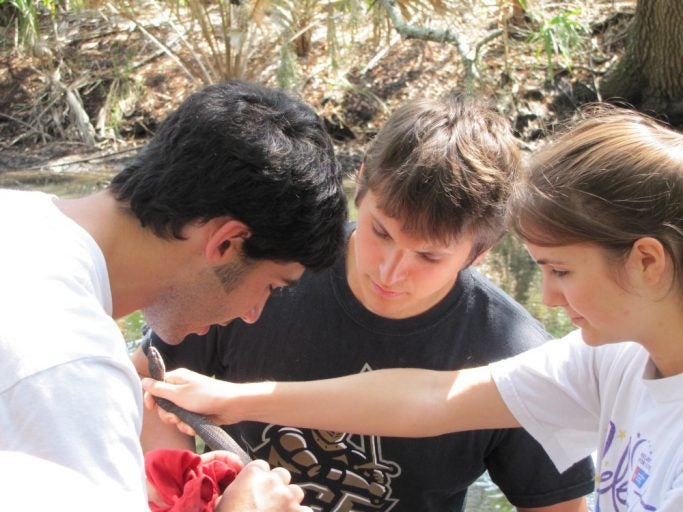Paddling under the moonlight in a caravan of canoes while lightning flashed along the skyline several miles away, a team of 25 University of Central Florida biologists and volunteers recently searched for the elusive Atlantic Salt Marsh Snake.
The group saw otters, alligators, jellyfish and other creatures, but not a single federally threatened Atlantic Salt Marsh snake was found at Tomoka State Park in Ormond Beach – thought to be the last stronghold for the snake in Florida.
A team of UCF biologists, students, volunteers and representatives from U.S. Fish & Wildlife Service searched day and night for five days earlier this month hoping to find the snake. But they struck out.
“There are several possible reasons for why we have been unable to find the snake in the Tomoka Basin,” said Gregory Territo, a UCF graduate student who coordinated the search. His thesis is focused on the genetics of the Atlantic Salt Marsh Snake. “The entire Tomoka Basin has been dramatically impacted by human development, as can be clearly seen through the mosquito ditching. It is possible that this development has made the habitat unsuitable for the Atlantic Salt Marsh Snake, and they are no longer present in the park.”
Another possible reason is that the marshes are difficult to traverse, and searching at night – when the snake is most active – is challenging.
“It is possible that the Atlantic Salt Marsh Snake is here, but that we have simply been unable to find them yet,” Territo added.
Wildlife officials are eager to find out the status of the snake because it has implications for how the park will be managed and it is a telltale sign of the health of the environment.
“We’d like to recover the snake,” said Bill Brooks, a recovery biologist with the federal agency. “They are an indicator of the health of the marsh and the impact of man.”
The park has been radically changed from its original state. In the 1960s, ditches were created and berms erected in an effort to control mosquitos in the area. That disturbance changed the salinity of the water, introducing fresh water to the historically saline environment – the natural habitat of the snake.
The team found 13 Florida Water Snakes during its expedition, which was a surprise because this species tends to dehydrate in salty environments.
“Our research has also uncovered an unexpectedly high degree of similarity between the salt marsh snakes and their freshwater relatives, which may have major implications for their conservation management,” UCF’s Territo said.
The Florida Water Snake looks very similar to the threatened Atlantic Salt Marsh snake, but lives in fresh water and is found routinely throughout Florida.
That’s why the UCF team is eager to clarify the relationship between the two snakes and see how genetically related they are, said UCF Associate Professor Christopher Parkinson who led the group.
For undergraduate student Michael Schrum, who volunteered to jump waist high into water to capture the reptiles, the mystery of where all the Atlantic Salt Marsh Snakes have gone is perplexing.
“It’s really interesting,” Schrum said while handling a Florida Water Snake. “It’s an awesome opportunity to do research and it is a lot of fun.”
